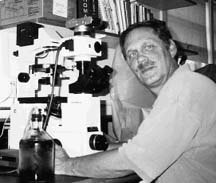
|
Archives:
Summer 2000
Table of Contents
As a boy who enjoyed summer vacations on Cape
Cod, Donald Cheney was always intrigued by seaweed, fascinated in
particular by the supple way it moves. "On the beach, seaweed
can seem like a mess," says Cheney, a marine biologist at Northeastern
University's Seaweed Biotechnology Laboratory in Nahant, Mass. "But
when observed in the water, its natural habitat, seaweed has a marvelous
flexibility." Cheney studied marine algae–of which seaweeds
constitute a multicellular form–both in college and graduate
school, and he's worked with seaweeds his entire professional career.
His lab has focused exclusively on red seaweeds, which he considers
the "prettiest" and most commercially valuable. In 1991, Coastal Plantations International (CPI), a Portland, Maine-based company since renamed Phycogen, began efforts to farm nori in Cobscook Bay of northern Maine using a non-indigenous species, Porphyra yezoensis, native to Japan. With support from MIT Sea Grant, Maine/New Hampshire Sea Grant and the National Coastal Research Institute, Cheney and his colleagues ran a biomonitoring program from 1996 to 1999 to see whether this exotic species posed a threat to the local ecosystem. The group set up nets downstream of the 10 square-kilometer seaweed farm and along the shore to see what kind of seaweed might attach and grow. As it is next to impossible to identify Porphyra species just by looking at the plant blades, the researchers used molecular genetic techniques to show that the foreign species, P. yezoensis, did in fact grow outside the cultivated area during the summer. But the plant could not survive the long, cold winters, meaning that a colony would not take root and replace local species. Although P. yezoensis did not pose a danger to the ecology of Cobscook Bay, CPI's efforts to harvest the plant faltered because of differences in growing conditions between northern Maine and Japan. The crop did well in the first year, which was cloudy and wet, but fared poorly in subsequent years because of too much sunlight. The company asked Cheney whether he could develop a strain that would grow better in Maine's climate, while still dying out in the winter to prevent a bioinvasion hazard. Again aided by MIT Sea Grant and Maine/New Hampshire Sea Grant, the Northeastern team took up the challenge to produce a strain with enhanced growth characteristics. Employing a technique called protoplast fusion, Cheney and his crew succeeded in combining cells of P. yezoensis with a local Porphyra species, P. umbilicalis. To do this, they immersed the cells in an enzyme for about two hours to dissolve the cell walls. Next they added polyethylene glycol, a chemical related to antifreeze, to the solution. The chemical binds to water, removing water molecules that separate the inner cells or protoplasts. If enough chemical is added, the protoplasts press close together. Then, if the right amount of water is thrown into the mix, the protoplasts expand, pushing together and "fusing." Unfortunately, this hydrid did not thrive. But when the researchers fused two P. yezoensis cells from different stages of the seaweed life cycle–one in the leaf phase, the other in the so-called filament stage–the resulting hybrid grew faster than the original. "Now we need to find another company interested in farming this strain," Cheney says. The experience has convinced him that genetic modification is vital to the success of a seaweed aquaculture industry in the U.S. Expansion of seaweed cultivation, he says, will mainly come from improvements to the culture species themselves, rather than from improvements in culture methods." Protoplast fusion, he adds, is not genetic engineering, since the DNA of nori cells was not changed by adding a foreign gene. The same fusion process could potentially occur in nature, he says. "We're just increasing the odds." The next logical step, as Cheney sees it, is to use genetic engineering to make seaweed more valuable than it is today. Genes have already been added to rice and tomatoes to make them produce more beta-carotene, a precursor to vitamin A. A similar manipulation could be done to nori as well, Cheney says. His group has already achieved the first genetic transformation of seaweed yet reported. Nori enriched with beta-carotene could help prevent the 500,000 cases of blindness caused in developing countries each year by vitamin A deficiencies. With other genetic manipulations, the seaweed might be used to produce drugs, vaccines, and nutritional supplements for humans or farm animals, says Cheney. "We think nori has a lot bigger future than just being eaten in sushi." |
